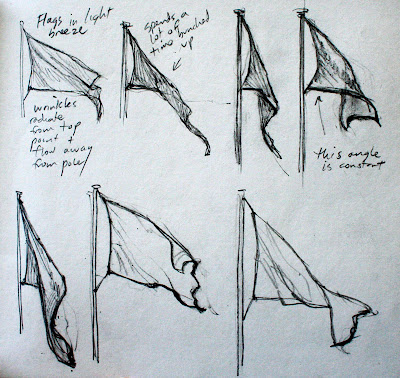In fairness, there’s nothing wrong with this way of drawing flags—if your goal is to represent the mental image of a flag. A cartoonist is usually after the mental image, not reality. It’s also a good way to represent a flag if you want to show the flag's graphic design clearly.

But if your goal is realism, it’s worth observing that flags never actually appear with undulating folds parallel to the flagpole. Instead, as many of you pointed out, a set of folds radiates diagonally downward from the upper point of support.
 I was unaware of this principle until a day in 1995 when I was stuck in rest stop during a long bus trip through the midlands of England. There was nothing to do but sketch and nothing to sketch but a flag. I drew a page of variations as the wind changed from a zephyr to a stiff breeze.
I was unaware of this principle until a day in 1995 when I was stuck in rest stop during a long bus trip through the midlands of England. There was nothing to do but sketch and nothing to sketch but a flag. I drew a page of variations as the wind changed from a zephyr to a stiff breeze.Here are some YouTube videos, which show waving flags better than my sketches.
Medium size flag in diminishing wind: Link
Small flag in stronger wind: Link
Small flag in heavy wind Link
Big flag in heavy wind: Link ; (In this last one, the diagonal rule breaks down a bit, and the wrinkles are more complex billows. They actually start to look a bit like the flag pictures from China and France, above. I have a feeling the math behind all this is pretty complex.)
Perhaps one of our CG animation friends might be willing to say a few words about the challenges involved in modeling this kind of action in 3D on a computer.
Well, it's hard to pick. The grand prize has to go to the first Anonymous (theartistsmith.com) who got the basic answer right away. The next four runners up who really described the action are: Kevin H, Dan G., Orlando M., and Meredith D. But I'm going to give the last runner up prize to Big E, who expressed the larger truth that there's no single correct way to represent reality; it depends what you want to communicate. If you’d like to collect your prizes, please email your mailing address to me at jgurneyart@yahoo.com.
Không có nhận xét nào:
Đăng nhận xét